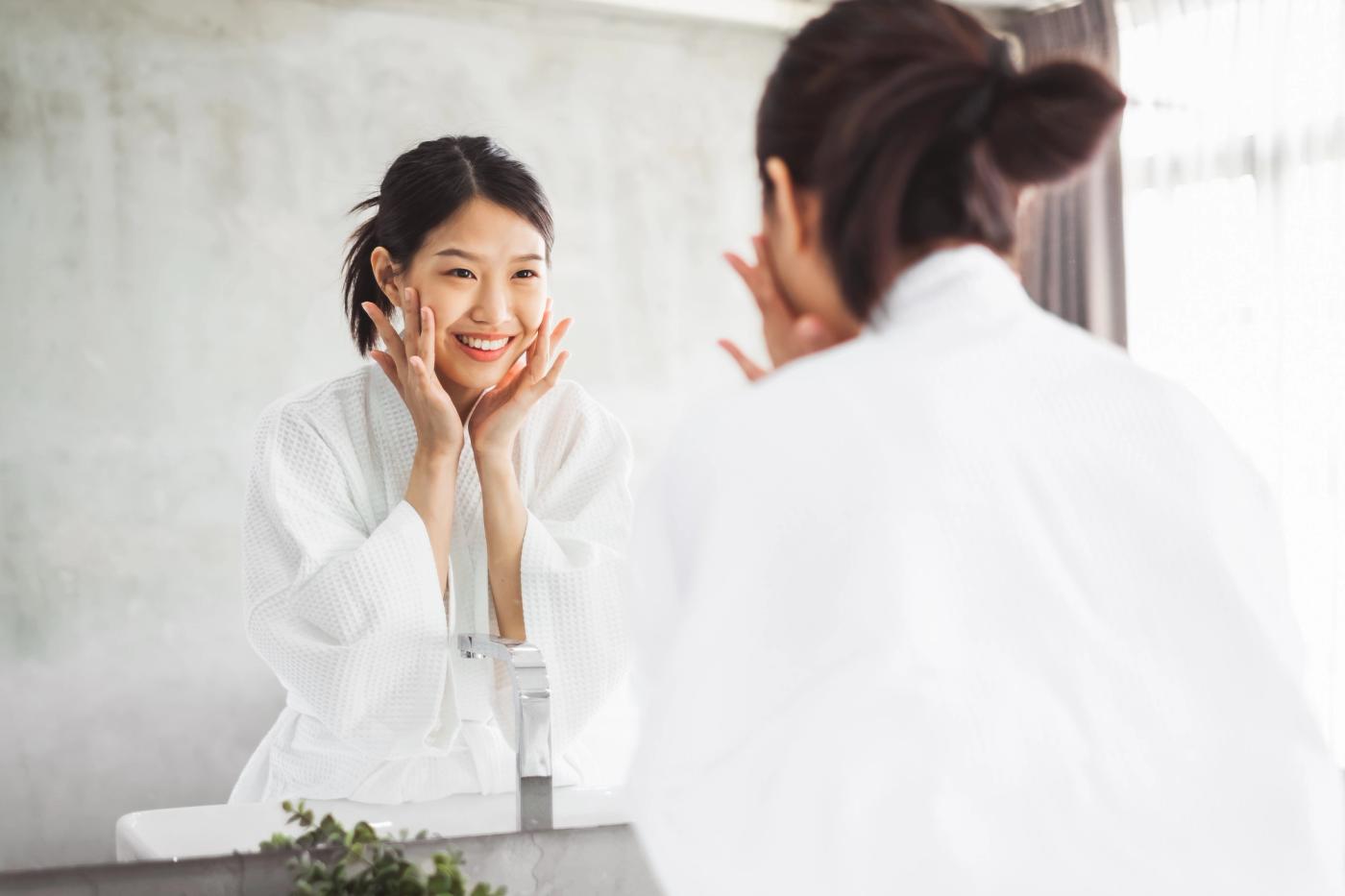What is Maskne?
As the name suggests, “maskne” is newfound acne or bumps or general irritation of the face area where your protective mask goes over. While your skin barrier helps protect you in many ways, friction, rubbing and sweat trapped underneath a mask can cause skin to get irritated, leading to breakouts on our chin, mouth, and nose areas.
The constant, no-air seal pressure from mask, friction heat, and sweat can cause irritation, allergic reactions, acne, lines and discoloration. Stress – both physically on the skin barrier, and internal stress during these more challenging times — can contribute to “maskne”.
What causes Maskne?
Wearing protective fabric over our faces for prolonged periods of time can take a toll on skin. And you may be tempted to reach for fast solutions, harsh drying ingredients, or just plain confused about how to approach this issue. To combat this newfound "maskne," it'll be key to understand the underlying cause for what might be triggering it in the first place — and addressing the issue more holistically.
Here are four main culprits that can trigger "Maskne":
- Acne Mechanica: The first culprit your newfound maskne could be caused by is a form of acne called acne mechanica. It’s caused by the combination of rubbing from the mask, which irritates the skin barrier, as well as the hot moisture trapped inside, which dilates the pores and allows bacteria and oil to clog them up.
- Skin Barrier Disruption: This can lead to acne (and even acne mechanica) but also other issues — like more reactive skin, even accelerated signs of aging, all signs that your skin barrier has been disrupted. Wearing a fabric over skin that constantly moves around, and coupling that with a moist, potentially even very heated environment as we constantly breathe into the mask, can result in wear and tear on the skin barrier.
- Dirty Masks: Using masks that are dirty and filled with bacteria can certainly exacerbate any existing issues or trigger new breakouts. Fabric masks, in particular, are prone to becoming petri dishes for bacteria to thrive. Make sure you’re washing your mask or spraying it down with 70% alcohol, for example, after you wear it. You don’t know what bacteria the mask has come in contact with and don’t want germs making their way into your nose and mouth. Make or buy a few masks, ideally in a softer fabric like a silk blend to reduce friction, so you can easily switch them out and wash them in-between uses. Important note: the most important element is the protective function of the mask. Your mask may not work well if it’s being sprayed down or washed (for example, some N95 masks should not be sprayed with alcohol), so be sure to check the directions so that you don’t compromise the protective function of your mask.
- Contact Dermatitis: In some instances, your reaction may not be acne at all, but a specific reaction to the fabric of the mask instead. Your mask itself can contain something that your skin is finding very irritating or finding to be an allergen. You may try one protective mask and be OK with it, and another type can suddenly break you out. With contact dermatitis, you may notice that your skin can get very inflamed, very red, very itchy — even weepy and rashy. The best thing to do here is to find the best kind of mask material for your skin that still provides the level of protection that you need.
So how do you combat Maskne?
There are universal things that help maskne, no matter what the cause, given the more stressed-out nature of skin when wearing masks. Here are three things to keep in mind:
- Be gentle with skin: Wash your face with a gentle cleanser before, and, after applying a mask in order to calm skin and prevent trapping bacteria under the mask and pushing it further into skin. If you’re using a harsh cleanser that strips skin dry, your skin will have a harder time withstanding all the stress induced by wearing a face mask. Try Power Calm Hydrating Gel Cleanser as it’s sulfate-free, low pH and hydrating and soothing.
- Hydrate, hydrate, hydrate: More hydrated skin tends to be stronger and healthier, so you’ll want to double down on hydration. What’s interesting is that when your skin flares up, you typically reach for something that is super-liquid-y and absorbent like an essence, but did you know that you can also boost hydration with a serum as well? You can’t go wrong with either the Wild Dew Treatment Essence and/or the Glass Skin Refining Serum. The Glass Skin serum formula includes niacinamide, which helps reduce inflammation and redness, hyaluronic acid to seal in hydration, madecassoside to help heal and fortify skin and peach extract to help nourish and bolster skin.
- Exfoliate gently: While it is important to exfoliate during this time, if skin is weakened, using a harsh exfoliator can damage the skin barrier. We recommend Good Acids Pore Toner, which sloughs away dead skin cells and is gentle enough for daily exfoliation on even the most sensitive skin. This formula includes a pore-refining blend of AHA, salicylic acid, and glycerin to both exfoliate and hydrate your skin.
Now, depending on your specific maskne culprit, on top of the above, here are solutions that can help:
To combat acne mechanica: Start with Acne Spot Dots hydrocolloid patches to speed the healing process. With more than 30 million patches sold, the OG of pimple patches promises to keep bacteria out with its hydrocolloid material, while absorbing secretions from breakouts that you’re trying to get under control. Not only does it help keep bacteria from re-infecting the area, but it also pulls out any fluid that’s trapped in your zit. Bonus: The dots come in three different sizes and are thin enough so you can wear them all day undetected, even under makeup. Exfoliation is a key step here and our Super Reboot Resurfacing Mask effectively and gently exfoliates, resurfaces and retexturizes skin, ungluing impurities deep within pores to reveal fresh, clear skin.
To help fortify a disrupted skin barrier: Add in ceramides and fortifying lipids — both are instrumental in strengthening the skin’s barrier, ultimately helping improve the skin barrier function in acne-affected skin. Incorporate an oil that can help fortify your skin barrier and doesn’t clog pores like Pure Beam Luxe Oil. A multi-purpose solve-all-salve like KBeauty Rescue Balm gives places that attract friction extra TLC. And Lazy Day Pads come pre-soaked with moisturizing and nourishing ingredients that deliver benefits deep into pores.
To keep masks clean: According to Jade Flinn, a nurse educator for the Biocontainment Unit at Johns Hopkins Medicine who specializes in personal protective equipment (PPE), a good rule of thumb is to treat your mask like you treat your undergarments. “I always recommend that you change your mask like you change your underwear: daily,” she says. You can launder DIY cloth masks or bandanas in the washing machine, but Flinn suggests washing them separate from your other garments. Opt for the hottest setting on both your washer and dryer and use regular laundry detergent according to the instructions.
Another important point Flinn makes: Be conscious of which parts of the mask you do and don’t touch in any part of the removal, sanitizing, or discarding process. Consider the exterior of the mask, and your hands, soiled after going out in public. “When you wear PPE, there should be a mindset change where you’re a bit more conscious of your environment,” she says. “It’s important to be aware of what you are touching.”
To combat contact dermatitis: A dermatologist can help and may prescribe a steroid or even suggest an over-the-counter hydrocortisone, but you should consult your doctor. In general, though, we recommend avoiding harsh products plus a skincare routine with skin-fortifying products and to double down on the hydration.
And if you’re looking for the best products to combat maskne all in one place, our Maskne Essentials collection includes our top picks from our estheticians to help you combat maskne and stay smooth-sailing.
Cheers to radiance, peaches!


